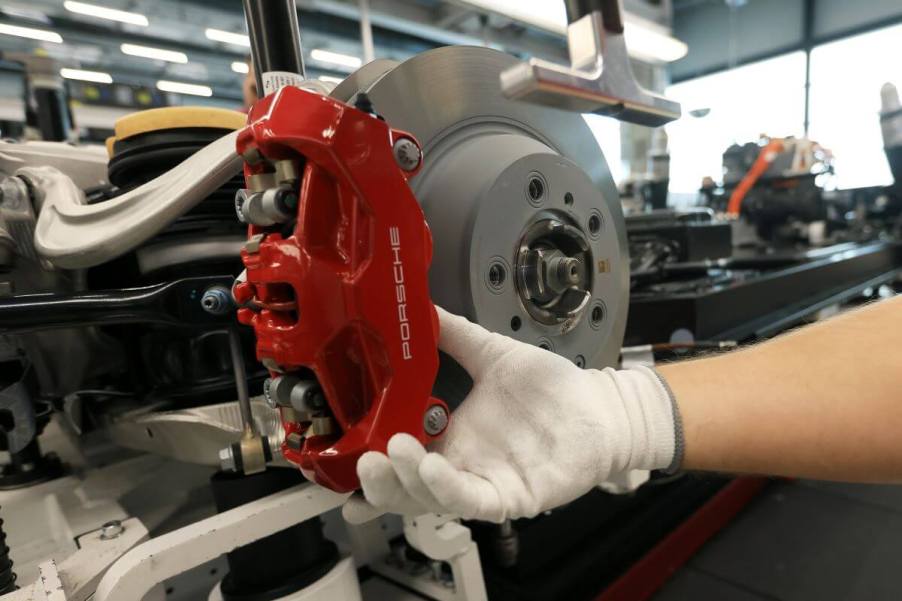
What’s the Difference Between a Fixed and Floating Brake Caliper?
It doesn’t matter how powerful, pragmatic, or pretty a car, truck, or SUV is if its brakes aren’t up to the task. Brake calipers serve as a critical component of braking systems. There are two main types of brake calipers, fixed or floating, so what is the difference, and which is the better choice?
Fixed brake calipers explained
Braking systems use several components to bring a car to a stop, and brake calipers are among the most notable. According to Haynes, brake calipers are installed on either one side or both sides of the brake rotor, which spins along with a car’s wheels. Using pistons, the calipers apply pressure to the spinning brake rotor, using brake pads, when the driver applies the brakes. The force of this action is determined by the braking force from the driver.
Fixed calipers and floating calipers operate similarly. Essentially, a master cylinder delivers pressurized hydraulic fluid to the calipers, which then apply force against the spinning rotor, slowing a car down or bringing it to a stop. Still, how fixed or floating calipers apply their stopping force varies.
Fixed calipers are “fixed” in the sense they do not have any moving components apart from the pistons and brake pads. Fixed calipers use pistons on each side of the brake rotor, and when the brakes are applied, the inboard and outboard pistons apply the same pressure to the rotor. The “clamping” action thus slows a vehicle.
Floating calipers offer a different approach
Unlike fixed brake calipers, floating brake calipers generally operate with a single piston on one side of the rotor.
According to Low Offset, a floating caliper’s piston(s) forces the brake pad against the inboard side of the rotor. Once contact between the pad and rotor is made, the piston remains in place. Then, the “floating” outer body of the caliper moves, using bushings or pins, to apply pressure to the opposite, or outboard, side of the rotor. This results in a clamping action slowing the car.
To compare fixed or floating calipers, consider catching a spinning basketball. Catching the ball using both hands simultaneously is akin to a fixed caliper system. Equal and simultaneous pressure is applied to each side of the basketball, allowing you to catch it and bring it to a stop. A floating caliper system is like using a single hand to reign in the basketball. The single hand doesn’t stop the basketball from completely spinning, but it essentially can act to hold the ball in place while your other hand moves to “clamp” the ball from the other side.
Fixed versus floating brake calipers: Which is better?
With equal stopping power applied immediately to both sides of the rotor, fixed brake calipers offer improved overall braking performance and therefore are most often used in high-performance cars. Brake pads on fixed caliper systems generally wear evenly and provide consistent performance. When the pads wear down, the pistons can automatically compensate by continuing to apply consistent pressure to the rotor. Additionally, fixed calipers are often made from more lightweight and heat-resistant materials, including aluminum, that dissipate heat more effectively, resulting in less dramatic brake fade. Finally, changing the pads is a more simplistic process for fixed caliper systems, as no brake disassembly is necessary.
However, fixed calipers have a significant disadvantage — they are more expensive. Additionally, fixed calipers are more complex, and issues like warped rotors can alter the position of the pistons in relation to the rotor, resulting in an inconsistent brake feel or performance. Fixed calipers are also bulkier, requiring larger wheels to accommodate them.
Floating calipers are smaller and far more economical to produce, which is why they are installed on most mainstream cars. Generally, they only use a single piston, which lowers the possibility of fluid leaks and makes bleeding the brakes easier.
However, fixed calipers have more moving parts, which can always increase the risk of issues. For instance, the slider pins, which clamp the outboard side of the rotor, can wear and result in lackluster performance, sometimes through uneven brake pad wear. Outside elements like dirt can also result in floating calipers “sticking.” Floating calipers typically heat brake fluid to a higher temperature, leading to increased brake fade.
The question of fixed versus floating calipers ultimately depends on their intended use. Fixed calipers are more advantageous in high-performance cars because of their improved performance. In comparison, floating calipers are smaller, cheaper to produce, and generally all that’s needed in commuter cars and family haulers.




